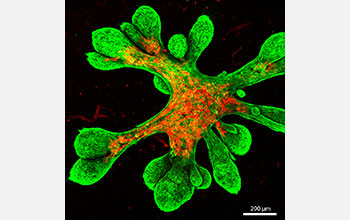Multimedia Gallery
Engineered hydrogel scaffolds enable growth of functioning breast tissue
A mammary tissue grown for 11 days in the lab that contains both of the differentiated cell types present in human breast tissue. In this image, basal cells are green, luminal cells are red.
More about this image
Breast cancer research has been largely confined to studying transformed cell lines in a dish or implanting cells from established human tumors into mice and other animal models of the disease. Although these models provide some insight into a cancer’s machinations at the cellular level, they fall short when investigating cancer initiation and progression within human tissue.
Researchers at the Whitehead Institute have created a hydrogel scaffold that replicates the environment found within the human breast. The scaffold supports the growth of human mammary tissue from patient-derived cells and can be used to study normal breast development as well as breast cancer initiation and progression. Ideally, scientists would be able to grow in a dish human mammary glands that mimic the body’s breast tissue, including its response to hormones that trigger development during pregnancy and lactation.
The research was supported by a National Science Foundation Graduate Research Fellowship Program grant (DGE 11-22374).
To learn more about this research, see the Whitehead Institute news story Engineered hydrogel scaffolds enable growth of functioning human breast tissue. (Date image taken: 2015; date originally posted to NSF Multimedia Gallery: Aug. 8, 2016)
Credit: Daniel Miller and Ethan Sokol, Gupta Lab, Whitehead Institute, MIT
Images and other media in the National Science Foundation Multimedia Gallery are available for use in print and electronic material by NSF employees, members of the media, university staff, teachers and the general public. All media in the gallery are intended for personal, educational and nonprofit/non-commercial use only.
Images credited to the National Science Foundation, a federal agency, are in the public domain. The images were created by employees of the United States Government as part of their official duties or prepared by contractors as "works for hire" for NSF. You may freely use NSF-credited images and, at your discretion, credit NSF with a "Courtesy: National Science Foundation" notation.
Additional information about general usage can be found in Conditions.
Also Available:
Download the high-resolution JPG version of the image. (1.3 MB)
Use your mouse to right-click (Mac users may need to Ctrl-click) the link above and choose the option that will save the file or target to your computer.



